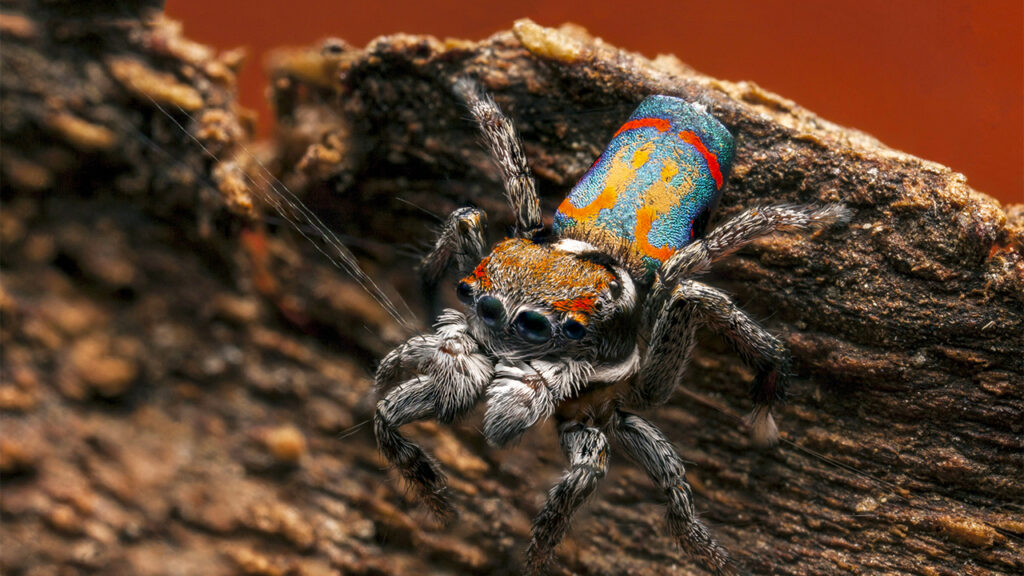A tarantula can jump up to 10-15 times its body length. Tarantulas are known for their impressive jumping abilities due to their strong leg muscles and flexible exoskeleton.
However, the distance they can cover in a single jump may vary depending on the specific species and individual tarantula. These spiders typically use their jumping skills for hunting prey or escaping from potential threats in their environment. While tarantulas are not typically aggressive towards humans, it’s important to approach them with caution to avoid any unnecessary confrontations.
We will explore the fascinating world of tarantulas and delve into their jumping skills, behavior, and unique characteristics. So, let’s get started and uncover the amazing world of these eight-legged creatures.
Unveiling The Astonishing Leap Of Tarantulas
Ever wondered just how far a tarantula can jump? Tarantulas may be known for their intimidating size and venomous fangs, but many people are surprised to learn that these creatures are also capable jumpers. Tarantulas use their powerful leg muscles to propel themselves great distances, allowing them to pounce on unsuspecting prey or escape potential threats.
Tarantulas have unique anatomical features that enable their impressive jumping abilities. Their legs are equipped with strong muscles, flexible joints, and specialized hairs called “tarsal claws” that help them grip onto surfaces. These adaptations give tarantulas the strength and agility needed to perform high-powered leaps.
With their incredible jumping skills, tarantulas can cover astonishing distances. While specific measurements vary among different species, it is not uncommon for tarantulas to jump several times their own body length. This remarkable feat showcases just how adaptable and remarkable these creatures really are.
So, the next time you encounter a tarantula, remember to appreciate its incredible leaping prowess, a testament to the wonders of nature’s design.
Understanding The Mechanics Behind A Tarantula’s Jump
Tarantulas are fascinating creatures known for their ability to jump surprisingly long distances. Their remarkable jumping skills are primarily attributed to their powerful leg structure. Tarantulas have multiple pairs of legs, with each leg consisting of sturdy joints that allow for the efficient storage and release of energy during a jump. These joints are reinforced with strong muscles that act as catapults, propelling the tarantula into the air.
The extraordinary jumping capabilities of tarantulas can also be attributed to their flexibility. These arachnids have highly flexible leg joints that enable them to quickly extend and contract their legs to generate a powerful spring-like force. By utilizing their muscle strength and flexible leg joints, tarantulas can launch themselves with surprising speed and accuracy to capture prey or escape potential threats.
Factors Influencing The Distance Of Tarantula Jumps
Size Matters: How Tarantula Size Impacts Jumping Performance
One of the key factors that affects the distance a tarantula can jump is its size. Larger tarantulas generally have more powerful leg muscles, allowing them to generate greater force and propel themselves further. Their increased body mass also contributes to a higher momentum during the jump, enabling them to cover a greater distance. On the other hand, smaller tarantulas may not have the same level of strength and momentum, resulting in relatively shorter jumps.
The Impact of Terrain on Tarantula Leap Distance
The type of terrain a tarantula finds itself in can also impact its jumping performance. Tarantulas thrive in diverse habitats ranging from forests to deserts, and the different surfaces and textures of these environments can affect their ability to jump. For instance, a tarantula in a more uneven or rough terrain might not be able to achieve the same level of push-off as on a smoother surface, resulting in shorter jumps.
Analyzing the Effect of Energy Levels on Tarantula Jumps
The energy level of a tarantula can significantly influence its jumping distance. When a tarantula is well-rested and has abundant energy, it can gather more strength to make powerful jumps. Conversely, a fatigued or low-enegy tarantula may not possess the same level of force or distance when jumping. Energy levels can also be impacted by other factors such as nutrition and overall health.
Unraveling The Secrets Of Tarantula Jumping Patterns
When it comes to tarantulas, their jumping abilities have always been a topic of fascination. These incredible creatures have evolved remarkable adaptations for effective prey capture. Their jumping patterns vary across different species, showcasing the diversity of hunting techniques employed. By studying these patterns, scientists aim to understand the factors that contribute to successful jumps and the strategies tarantulas employ to catch their prey.
Tarantulas possess specialized leg muscles and body structures, allowing them to execute precise jumps. Their remarkable speed and agility enable them to adapt to different hunting environments. Comparing the jumping patterns of various tarantula species has revealed interesting insights into their hunting strategies. Some species rely on long-distance jumps to capture elusive prey, while others use short jumps combined with stealthy approaches. These diverse jumping patterns not only reflect the tarantulas’ unique hunting techniques but also shed light on the intricacies of their ecological niche.
The mysteries surrounding tarantula jumping patterns continue to captivate researchers, driving further exploration into the fascinating world of these enigmatic creatures.
Unveiling The Evolutionary Significance Of Tarantula Leaping
Jumping behavior in tarantulas is a remarkable adaptation that has evolutionary significance. These large spiders, known for their size and venomous nature, are surprisingly agile and capable of impressive leaps. The evolutionary arms race between predator and prey has driven the development of incredible escape mechanisms in potential prey, which has in turn influenced the evolution of tarantulas. Research has shown that tarantulas have developed specialized adaptations to enhance their jumping ability, such as enlarged leg muscles and modified leg joints. These adaptations allow them to quickly and effectively capture prey or evade predators. The jumping behavior of tarantulas has important implications for their survival, as it provides them with a means of obtaining food and escaping danger. By studying and understanding tarantula leaping, we gain valuable insights into the complex and fascinating world of predator-prey interactions and the evolutionary adaptations that arise as a result.

Credit: www.csmonitor.com
The Intriguing World Of Tarantula Research And Observation
When it comes to the study of tarantulas, researchers have made fascinating discoveries using cutting-edge technologies. These advancements have allowed scientists to gain a deeper understanding of how far tarantulas can jump and the underlying mechanisms behind their impressive leaping abilities.
One notable tool in tarantula research is high-speed videography, which allows for detailed analysis of the movement and behavior of these arachnids. By capturing their jumps at incredibly fast frame rates, researchers can observe the precise moments tarantulas extend their legs and propel themselves into the air. This technology has shed light on the biomechanics involved in their incredible jumps.
Another method utilized in tarantula research is 3D imaging and modeling. By using specialized software and scanning techniques, scientists can create accurate digital representations of tarantulas and their intricate leg structures. This enables them to simulate and analyze the forces and stresses experienced during jumps, providing further insights into the limits of their leaping capabilities.
| Citizen Science in Tarantula Research |
|---|
| Additionally, citizen science initiatives have played a significant role in tarantula research. Enthusiastic individuals from around the world have contributed their observations, photographs, and even videos of tarantula behavior. This collective effort has expanded the scope of research and provided invaluable insight into the natural behaviors of tarantulas in various environments. |
In conclusion, thanks to cutting-edge technologies such as high-speed videography and 3D imaging, as well as the contributions of citizen scientists, we have been able to delve deeper into the intriguing world of tarantula research. These advancements continue to reveal remarkable aspects of tarantula behavior and capabilities, helping us appreciate the fascinating world of these arachnids.
The Fascination Continues: Unlocking More Tarantula Mysteries
Unlocking more mysteries surrounding tarantulas, this captivating article delves into the intriguing question: How far can a tarantula jump? Discover the astonishing abilities of these arachnids as we unveil their hidden talents.
Exploring Unanswered Questions About Tarantula Jumping Abilities
When studying tarantulas, one cannot overlook the intriguing question of their jumping abilities. Tarantulas are known for their agility, but how far can they really jump? Researchers have embarked on a quest to unravel this mystery, delving deep into the world of these enigmatic creatures.
The Potential Applications of Tarantula Jumping Studies cannot be understated. By understanding the mechanics behind their jumps, scientists can gain valuable insights into the design and development of bio-inspired robots. The remarkable jumping abilities of tarantulas hold great promise for innovations in fields such as advanced locomotion and search-and-rescue missions.
| Jumping Distance | Impressive Precision | Mechanical Adaptations |
|---|---|---|
| Tarantulas can leap distances exceeding their body length, sometimes up to several feet. | They exhibit astonishing accuracy in landing on targeted surfaces, even in low-light conditions. | Their legs possess specialized adaptations, such as modified joints and scopulae, enabling efficient propulsion and grip. |
These findings demonstrate that tarantulas are truly remarkable creatures, thriving in various habitats around the world. Their jumping abilities are an integral part of their survival and play a significant role in their natural behavior, including prey capture and evading predators. By diving deeper into the mysteries of tarantula jumping, scientists continue to uncover new insights that could shape the future of robotics and beyond.
Frequently Asked Questions Of How Far Can A Tarantula Jump
How Far Can A Tarantula Jump?
Tarantulas have strong legs that allow them to jump distances of up to 10 inches. However, their jumping ability is used more for defense and escaping predators rather than for hunting prey. Despite their impressive jumps, most tarantulas prefer to rely on their stealth and patience to catch their prey.
Conclusion
The jumping ability of tarantulas is fascinating and often misunderstood. While they can’t leap as far as some other animals, their agility and quick movements allow them to navigate their environment with impressive ease. Understanding the jumping capabilities of a tarantula can provide valuable insights into their behavior and evolutionary adaptations.
Whether you’re a tarantula enthusiast or simply curious about our eight-legged friends, exploring their unique abilities is always an intriguing journey. So, next time you encounter a tarantula, remember that their jumps may be shorter but their world, filled with survival strategies, is vast.
